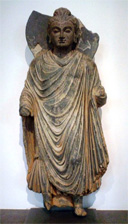DUSHANBE (Asia-Plus) — The first cultural and historical exhibition dedicated to Tajikistan is expected to take place in Paris in November next year. The exhibition will be held at the Guimet Museum.

- Yasmine Gouédard
Speaking at a press-briefing dedicated to France’s national holiday, Bastille Day, which is marked on July 14, Mrs. Yasmine Gouédard, Ambassador of France to Tajikistan, noted that the exhibition would include several directions: archaeological exhibition; photo exhibition; concert of national music and poetry; and conference on language.
French diplomat supposes that the forthcoming event will have a good effect on Tajikistan’s tourism sector.
The famous (Musée national des arts asiatiques known as Musée Guimet is an art museum located in the 16th arrondissement of Paris It has one of the largest collections abroad of Asian art. Founded by Émile Étienne Guimet, an industrialist, the museum first opened at Lyon in 1879 but was later transferred to Paris, opening in the place d’Iéna in 1889.

- Standing Buddha
- Ancient region of Gandhara, northern Afghanistan, 1st century. (©: public domain)
Devoted to travel, Guimet was in 1876 commissioned by the minister of public instruction to study the religions of the Far East. Thus, the museum contains many of the fruits of this expedition, including a fine collection of Chinese and Japanese porcelain and many objects relating not merely to the religions of the East but also to those of ancient Egypt, Greece and Rome. One of its wings, the Panthéon Bouddhique, displays religious artworks.
From December 2006 to April 2007, the museum hosted collections from the National Museum of Afghanistan in Kabul, with archaeological objects from the Greco-Bactrian city of Ai-Khanoum (once called the Alexandria on the Oxus), and the Indo-Scythian wealth of Tillya tepe, an archaeological site in the northern Afghanistan province of Jowzjan.
Exactly when Buddhism became established in Bactria is still much disputed. Some scholars argue in favour of the first century BC, or even earlier, while others maintain that its spread was due to the Kushans. Kushan influence certainly extended well into China in the first centuries AD. It is similarly uncertain at what date Buddhism penetrated into Chinese Turkistan. Late traditions associated the foundation of Khotan with the son and minister of Aśoka.


Meherban Karim (26 January 2019, 08:57)
Deer Madam/Sir,
We live in Pakistan and have Tajik culture, we are migrated from wakhan area of Afghanistan, we are working for the Tajik cultural development. we want to participated in the exhibition in Pairs. please guide us for that
Regards
Meherban Karim Gen.secretary